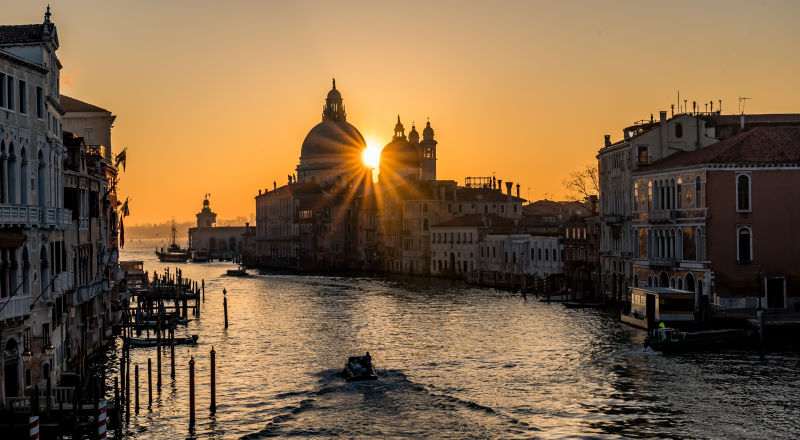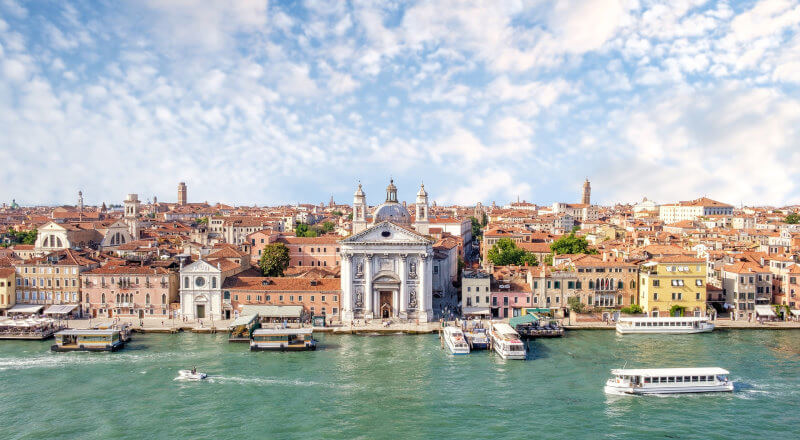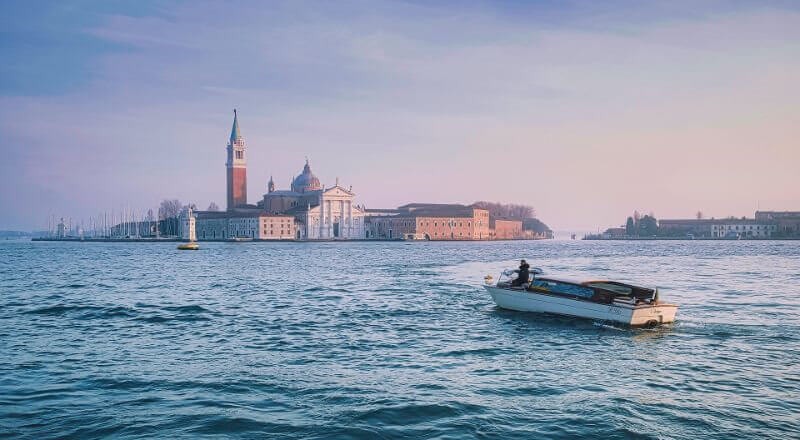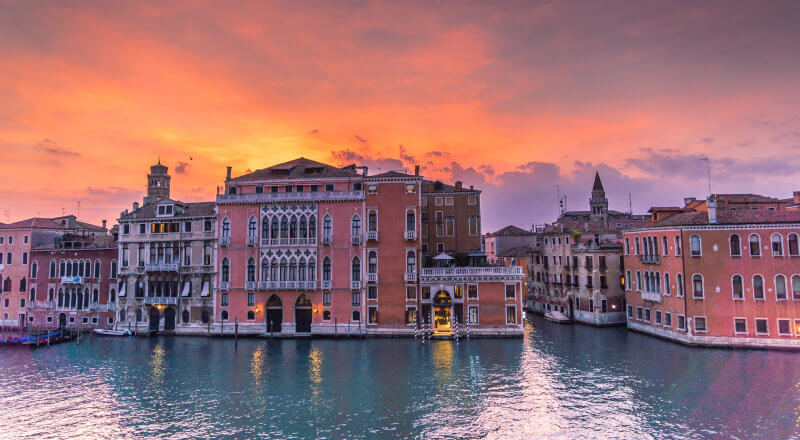Did you know?
In 1608, the Council of Ten proclaimed that wearing masks was approved only during the carnival. The penalties for breaking the law were strict like two years imprisonment and public beating.
In this article
What’s your interpretation of an ideal holiday to Venice? Do you think it’s just a romantic trip to another popular Italian city? Far from it.
This seductive city with over 100 canals, hundreds of bridges, glorious palazzos, and picturesque piazzas has a charm that surpasses its touristy reputation. If you know how to move around the town and where to go, a whole new world will be revealed to you!
To find out all you need to know about planning a holiday to Venice, along with some useful travel tips, all you have to do is read on!
Explore more: Venice things to do | Venice best hotels

Built on the water and having canals instead of roads (hence its moniker “The Floating City”), this car-free Renaissance gem is nothing like what you’ve seen before. Thanks to its glorious history, Venice is full of architectural masterpieces, like the St. Mark’s Basilica, the Piazza San Marco, the Doge’s Palace, and the Galleria dell’ Accademia.
Stick with us to find out all you need to know about Venice, from the best things to do and must-visit attractions to how to get there and where to stay in Venice!

Venice is a group of 118 islands divided by 150 canals and connected by 400 bridges. Some islands of the Venetian Lagoon are large and host imposing churches, glorious palaces, squares, museums, restaurants, and shops.
This 1,700-year-old city is famous for its romantic atmosphere and Renaissance beauty. The picture-perfect canals, traditional gondoliers, and rustic brick buildings ooze a unique charm. Behind the canals of Venice, you’ll find cobblestone alleys, enormous cathedrals, lavish palaces, and a wide selection of hip shops and restaurants.
Some of the most famous attractions in Venice are the world-renowned Grand Canal thoroughfare, Piazza San Marco -the central square in Venice, the Campanile bell and the stunning St. Mark’s Basilica.
Venice is located in the Veneto region in Italy, in the northern part of the country. It comprises 118 big and small islands separated by canals and linked by over 400 bridges on the Venetian Lagoon.
Read also: Rome holidays travel guide | Naples holidays travel guide | Milan holidays travel guide | Florence holidays travel guide
Venice has a subtropical/ Mediterranean climate with hot summers and cold, rainy winters. The overall atmosphere in Venice city is humid, because of its location in the Venetian Lagoon.
Venice partially floods in winter and fall due to the ‘acqua alta’ (high water) phenomenon, which causes exceptional tide peaks on the shallow waters of the Venetian Lagoon.
Autumn (September to November)
Highest: 75 F/ 24 C Lowest: 39 F/ 4 C
Winter (December to February)
Highest: 48 F/ 9 C Lowest: 32 F/ 0 C
Spring (March to May)
Highest: 72 F/ 22 C Lowest: 39 F/ 4 C
Summer (June to August)
Highest: 82 F/ 28 C Lowest: 61 F/ 16 C
In 1608, the Council of Ten proclaimed that wearing masks was approved only during the carnival. The penalties for breaking the law were strict like two years imprisonment and public beating.
St. Mark’s Basilica is one of the most impressive attractions in Venice. This imposing 11th-century cathedral looks stunning from the outside but it’s even more impressive on the inside. From the art pieces that decorate the church to the domes on the top of the cathedral, St. Mark’s Basilica has a unique architectural charm.
One of the best things to do in Venice is to eat Cicchetti, a delicious local specialty. Cicchetti is a selection of bite-sized snacks like olives, cheese, bread topped with fish, tomatoes, cheese, and other delicacies. It is similar to the Spanish tapas and is served along with wine at the local bars.
Venice is one of the most romantic cities in the world, so it offers plenty of activities for couples. The ultimate thing to do in Venice with your significant other is to go for a gondola ride through the canals -gondoliers may as well serenade you! This not only an utterly romantic activity but also a good way to explore the canals of Venice, the picturesque bridges, and the picture-perfect buildings on the way.
The 400-year old Rialto Bridge (Ponte di Rialto) is the main bridge that crosses the Grand Canal. Close to the bridge lies the Rialto Market, a lively food market with lots of little shops selling local products.
Saint Marco Square is a must-visit place in Venice not only because of the cathedral but also thanks to its charming atmosphere and unique architecture. St. Mark’s Square also houses St. Mark’s Campanile, the Doge’s Palace, and Torre dell’Orologio. It is lined with many beautiful sidewalk cafés and bistros with live music, where you can sit and enjoy an authentic Italian espresso.
The impressive Doge’s Palace lies at the St. Mark’s Square, alongside the Grand Canal. It is considered one of the most important buildings in Venice, as it is strongly connected to the city’s history. On your visit to the Doge’s Palace, you’ll get the chance to learn about the ancient republic and marvel at the incredible architecture of its interior.
Related: 19 Best things to do in Venice (Italy) from Canals gondola rides to Saint Marco walks and more
Most shops in Venice open at 9 am and close at 7.30 pm. They are usually closed from 1.00 pm to 4 pm for a lunch break.
Most stores are closed on Sundays, except for some big retail shops and souvenir shops. Keep in mind that most of the clothing and gift stores are closed on Monday mornings, while most food stores are closed on Wednesday afternoons.
Population
270,884 (2020)
Currecy
Euro
Language
Italian
Average Temperatures
Warmest Month: July 82 F/28 C
Coldest Month: January 32 F/0 C
Tipping
If the bill includes a service charge, there’s no need to leave a tip. However, you can leave an additional 5%-10% of the total price of your meal. If the bill doesn’t include a service charge, you can leave a tip of 12% of the total price.
Loved by
Couples, honeymooners, families, elderly.
Venice, the capital of the province of Venezia and the region of Veneto, boasts an enduring history, as it is 1,700 years old! The “floating city” is a major European art, music and political hub since the early days of its cultural history.
In the late Medieval years, it was the most important seaport in Europe and the continent’s commercial and cultural link to Asia. Up to this day, it remains one of the biggest Italian ports in the northern Adriatic Sea.
Venice city is located in the Veneto region, in the northeast part of Italy. You can reach it by train, air, bus, or ferry from other European cities.
Marco Polo Airport is the main International airport in Venice and the third busiest airport in Italy. Marco Polo receives daily flights from major European cities, like Frankfurt, Paris, and Amsterdam, as well as from the United Kingdom, North America, and the Middle East.
There are frequent direct flights to Venice from several cities in the United Kingdom. The duration of the flight from the UK to Venice is about two hours from southern England.
The main low-cost airlines that fly from the UK to Venice are Ryanair (from Bristol, East Midlands, Leeds Bradford, and London Stansted), EasyJet (from Bristol, Edinburgh, London Gatwick, London Luton, and Manchester), and British Airways (from London Heathrow).
Several airlines fly directly to Marco Polo Airport in Venice from the United States, mainly in peak season. Some of the major airline companies that serve this itinerary are Delta Airlines and US Airways. Delta Airlines offers direct flights from JFK Airport in New York to Marco Polo in Venice. The US Airways offers direct flights from Philadelphia to Venice. Alitalia offers connecting flights to Venice from New York, Boston, and Miami.
If you’re planning on traveling to Venice from a European city, a ferry to Venice is a good option. The Port of Venice is one of the largest ports in the Mediterranean Sea. From Venice port depart ferries, cruise ships and high-speed vessels to cities like Croatia, Slovenia, Egypt, Syria, and Greece.
Santa Lucia Train Station (Ferrovia Venezia Santa Lucia) is the main train station in Venice. It is housed in a World War II building in the lagoon and receives about 30 million passengers every year!
Another major train station in Venice is the station located in Mestre (Ferrovia Venezia Mestre). Upon their arrival at Mestre, travelers must take the bus to get to Venice. You can check the schedules and prices of trains and buy your tickets online in the official websites of the TGV or Ferrovie dello Stato.
Cars are banned in Venice. However, if you choose to travel to Venice by car, you can park at Piazzale Roma or Tronchetto, a little island in the Venetian Lagoon. From there, you can take the bus or a small ferry to reach Venice city center. Alternatively, you can park your car at Fusina or San Giuliano, near mainland Mestre.
Same as with cars, buses are not allowed in Venice. However, it is possible to reach Venice by bus. The main international bus terminal in Venice is located in Piazzale Roma, at the Venetian extremity of Ponte della Liberta. From there, you can take a water taxi to get to the city of Venice.
You can also use the bus to get from the airport to your hotel in Venice. ATVO is the main bus company that serves itineraries between the Marco Polo Airport and Venice city center, as well as between many cities and resorts in the northwest part of Italy, like Venice, Jesolo, Bibione, Lignano, and Treviso.
San Marco: San Marco is one of the most popular and beautiful districts in Venice. It is located in the heart of the city and is home to some of the most important attractions in Venice, like St. Mark’s Square and Rialto Bridge!
Some of the best hotels in San Marco are: Baglioni Hotel Luna, Hotel Ala, Bauer Palazzo, The St. Regis Venice, and The Gritti Palace
San Polo: San Polo district is one of the oldest and busiest neighborhoods in Venice city, so it’s very popular with tourists. It is located in the central part of Venice and is well-connected to Saint Marco and the main points of interest in Venice. Don’t miss Venice Rialto Market, an open-air fish and vegetable market that takes place in San Polo every morning.
Some of the best hotels in San Polo are: H10 Palazzo Canova, Hotel L’Orologio, Riva del Vin, Ca’ Angeli, Palazzo Morosini Degli Spezieri, and Residenza Corte Molin
Cannaregio: Cannaregio, the second largest district in Venice, is located in the northern part of the city. At Cannaregio, you’ll find several sights, beautiful squares (campos),as well as a variety of budget-friendly hotels.
Some of the best hotels in Cannaregio are: Al Mascaron Ridente, Hotel Principe, Ca’ Bonfadini Historic Experience, Carnival Palace, and Arcadia Boutique Hotel
Dorsoduro: Dorsoduro is a very artistic neighborhood with unique character. Full of fascinating street art and amazing museums, like the Accademia Museum and the Guggenheim Art Collection, Dorsoduro will seduce art lovers!
Some of the best hotels in Dorsoduro are: NH Venezia Rio Novo, Palazzo Veneziano, Hotel Nani Mocenigo Palace, Hotel Moresco, and Hotel Palazzo Stern
Castello: Castello is a beautiful district that covers the area from the town center and the Rialto Bridge to the Arsenale naval base and the Giardini Gardens. It is a quiet neighborhood with green parks and squares -a beautiful district to explore. Castello is the perfect place to stay if you seek relaxation.
Some of the best hotels in Castello are: Hotel Danieli, Hotel Metropole Venezia, Hotel Ai Cavalieri di Venezia, Ruzzini Palace Hotel, and Hotel Ai Reali
Related: Venice best hotels and places to stay
Cars and buses are banned in Venice, so you have to opt for other more traditional options like walking, gondolas, and water taxis. Besides, Venice has canals instead of roads!

Venice is a walkable and flat city, so getting around on foot is the best option. What’s more, walking is an ideal way to explore the cityscape and marvel at the postcard-like views of the Venetian Lagoon.
Vaporetto (water bus) is a very popular means of transportation in Venice, ideal for taking in the picturesque scenery. ACTV runs all public transport in Venice, including vaporetti. The ferry routes that connect Venice with Murano, Lido, Torcello and other islands of the Venetian Lagoon are offered by another ferry provider. A one-way vaporetto ticket costs €7.50 ($8.13) and is valid for 75 minutes. You can purchase vaporetto tickets online or at the ticket offices scattered all around the city.
Tip: For better planning, ferry schedules, and online tickets check the vaporetto app daAaB. If you purchase tickets through the app, you can validate them by scanning your phone at the ticket validation barrier.
Although pricey, water taxis are a convenient way to get around the city. Water taxi fares are not fixed, but negotiated in advance. Official rates start at €15 ($16.25) plus €2 ($2.17) per minute, but there are additional charges:
Extra €5 ($5.42) if you call the water taxi to pick you from your hotel.
There’s a €10 ($10.83) surcharge for night trips (10 pm to 6 am).
Extra €5 ($5.42) for additional luggage (above five pieces).
There’s a €10 ($10.83) surcharge for each extra passenger after the first four passengers.
A gondola is the most romantic way to get around the city! Keep in mind though that gondola rides are on the pricey side. A gondola ride costs €80 ($86.67) for 40 minutes during the day and €100 ($108.34) for 40 minutes during the night (7 pm to 8 am). These prices don’t include tips and singing.
For a longer gondola ride, there is an additional charge (€40 ($43.34) during the day and €50 ($54.17) during the night) for every extra 20 minutes.
You’ll find gondola stops (stazi) along the Grand Canal and close to major attractions in Venice. Alternatively, you can book a pickup calling Ente Gondola (+39 041 528 50750).
Venice is a quite expensive city, but it is possible to enjoy your Venice holiday without breaking the bank. Hotels in Venice are rather expensive, especially on the main island. However, you can opt for a hotel out of the city center, on the mainland.
Alternatively, you can plan to visit Venice off-season, when hotels are way cheaper and the city is less crowded. As for entertainment, it doesn’t have to be necessarily expensive! Walking, sightseeing, and city exploration are some of the best things to do in Venice for free.
The average price of a 7-day trip to Venice for a couple is $3,300 (€3,038) and $6,200 (€5,708) for a family of 4. The room prices of hotels in Venice range from $100 (€92.30) to $500 (€460) per night, depending on the area and the hotel type. If you’re planning to travel with your family or with a group of friends and want to book an entire house rental, it will cost about $230 (€212) to $500 (€460) per night.
International flights to Venice are also quite expensive. An air ticket to Venice will cost about $700 (€644) and $1,200 (€1,105) per person on average for an economy seat. Flights to Venice from European countries are usually much cheaper. The cost of entertainment, transportation, and food will be about $50 (€46)-$150 (€138) per person per day.
Cicchetti, a traditional Venetian appetizer, is a selection of finger foods served along with a glass of wine or Spritz. It’s very similar to the Spanish tapas or Milan aperitivo. You can enjoy cicchetti with wine at one of the numerous bàcari (local bars) scattered all around Venice. Cicchetti is an ideal way to enjoy wine and food in Venice on a budget, as they cost about €1 to €3 per plate.
Baccalà Mantecato is a traditional Venetian dish made of stockfish, olive oil, garlic, black pepper, salt, and lemon juice. The history of this local specialty starts back in 1.431 when a Venetian ship packed with spices was caught in a storm. The sailors who survived were beached off Roest island, where they found dried stockfish. They brought the stockfish with them back in Venice and created this delicious dish.
Schie is a kind of shrimp found only in the Venetian Lagoon. Polenta is boiled cornmeal served as a hot porridge. The combination of the two used to be very popular with low-income Venetians. Today, the ingredients of this dish are hard to find, so Polenta e Schie is a unique specialty. The modern recipe consists of Schie cooked and seasoned with lemon, garlic, salt, and pepper, along with a side of hot polenta.
Sarde in Saor is a popular antipasto dish usually served as an appetizer. It consists of sardines and onions with a sprinkle of balsamic vinegar. It has a strong flavor and it is perfectly paired with wine.
The health care system in Venice is generally good, but it’s better to plan ahead. And by that we mean it’s a good idea to bring your medications with you and make sure you have a Health Insurance that covers you.
In case of emergency, you should go to the pronto soccorso (casualty section) of a public hospital, where you can receive treatment. Make sure you have your ID/passport and Health Care card with you.
Vaccinations for mumps, pertussis, measles, rubella, polio, pneumococcal, and hepatitis B are recommended by the World Health Organization.
Summer in Venice is pretty hot and humid, so lightweight breathable fabrics are essential to survive the heat! Don’t forget to bring with you cotton t-shirts, summer dresses, linen pants, and a pair of comfortable sandals suitable for walking. A light raincoat might also come in handy, as sudden thunderstorms are frequent in Venice.
Fall in Venice is generally rainy and unpredictable, so it’s better to cover all the bases when it comes to packing. Get with you a raincoat, rain boots, warm sweaters and pants, and scarves.
Winter in Venice is pretty cold and windy. Rain and snow are also common, at such a rate that they may flood the streets in Venice! So, your suitcase must include a water-resistant warm coat, a pair of warm gloves, scarves, sweaters, and leather boots. Remember: layering is the key!
Springtime in Venice is amazing in terms of weather! The weather is usually sunny attracting many visitors, especially at Easter. Comfort is really important when packing for a spring holiday in Venice. Bring with you cotton t-shirts, some pairs of jeans, a pair of comfortable sneakers, and a medium-weight jacket.

Enter your email to download your postcard in PDF
Muranno glass
Traditional masks
Burano lace
Handmade pasta
Venetian Carnival costumes
Gondolier’s hats
Grappa
Baicoli biscuits
Do you have any tips or recommendations about travelling to Venice? Tell us in the comments! If you liked this article, don’t forget to share it on Social Media!
Other Travel Guides you may be interested in: Rome holidays travel guide | Milan holidays travel guide | Naples holidays travel guide | Florence holidays travel guide | London holidays travel guide | Paris holidays travel guide | Amsterdam holidays travel guide | Tokyo holidays travel guide

Your email address will not be published. Required fields are marked.*